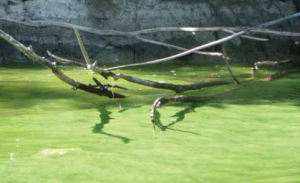
Algae is apparently worsening on Lake of the Woods, but the causes remain almost as murky as the water. Studies of the sediment on the lake bottom indicate that the usual suspects are apparently not to blame for a problem that has been growing for several decades.
Nutrient issues in the watershed, often caused by excessive runoff containing phosphorus and nitrogen, are getting neither worse nor better—especially in the largest source of water for Lake of the Woods, the Rainy River. Instead, warmer weather in recent decades might be the main culprit.
The latest information comes for a draft study released this summer by the International Joint Commission, the governing body of waters shared by Canada and the United States, and the Lake of the Woods Water Sustainability Foundation (LOWWSF), a group founded in 2005.
“This updated report focuses on the new science and provides a wealth of information for next steps toward long-term sustainability of the waters of the basin,” stated Todd Sellers, LOWWSF Executive Director.
“In recent decades the implementation of regulations for treatment of industrial and domestic waste effluent has led to significant reductions in nutrient loads to the Rainy River,” a summary version of the study states.
But the algae is still growing.
“These seemingly contradictory circumstances are the result of a complex process whereby climate change is influencing bloom intensity and where algae have access to additional nutrients from the lake sediments (internal loads) in some areas,” the report states.
Considered a highly productive lake, algae has been a natural part of it since at least the first Europeans visited the area, noting the blooms. But layers of sediment extracted from the bottom of the lake tell the tale of increasing algae since the 1960s. This correlates with the region’s changing climate, as the lake is ice-free (and warming up) for almost a month longer every year than it did six decades ago.
“Certainly, Lake of the Woods is a dramatic demonstration of climate change,” LOWWSF director Sellers told Minnesota Public Radio News.
Resort owner Nick Anthony of Ballard Resort told MPR News that the water quality gets bad as the summer progresses. “It gets green. For sure. It would take a pretty good bet from a buddy to jump in. It’s pretty nasty,” Anthony said.
The summary and full version of the study are available for download here.
Public meetings
The Draft Plan of Study for Lake of the Woods will be discussed at several meetings this month in both countries.
| CANADA | UNITED STATES | |
| Wednesday, August 13 2:30-4pm Best Western Lakeside Inn 470 1st Ave S, Kenora, ON |
Monday, August 11 7-8:30pm Mini-Theatre – Warroad High School 510 Cedar Ave NW, Warroad, MN |
|
| Wednesday, August 13 6:30-8pm Ojibways of Onigaming First Nation 703 Kele Mii Kana Rd (off Hwy 71 between Sioux Narrows and Nestor Falls), ON |
Tuesday, August 12 Open House 6-9pm Rainy River Community College 1501 Highway 71, International Falls, MN |
|
| Thursday, August 14 10-11:30am Economic Development Office 214 Main Street West Atikokan, ON |
Thursday, August 14 5:30-7pm Red Lake Community Centre Red Lake, MN |
|
| Friday, August 15 3-4:30pm Rainy River Recreation Centre 302 Broadway Ave, Rainy River, ON |
Friday, August 15 9-10:30am Vermilion Community College Theatre 1900 East Camp St., Ely, MN |
Written comments can be submitted to the Study Team through its website at: ijc.org/en_/LWBWQPOS/ or by mail to:
Kelli Saunders, Secretary, LOWBWQ Study Team
International Watershed Coordinator
47 Donbrock Drive, Kenora, ON Canada
P9N 0A2

